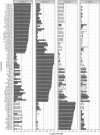Metabolic profiling of adherence to diet, physical activity and body size recommendations for cancer prevention
- PMID: 30390014
- PMCID: PMC6214951
- DOI: 10.1038/s41598-018-34662-7
Metabolic profiling of adherence to diet, physical activity and body size recommendations for cancer prevention
Abstract
Maintaining a healthy body weight, eating well and being physically active lowers cancer risk by 30%. However, the biology underlying these relationships is not well understood. We examined cross-sectional associations between metabolites and cancer preventive behaviors as well as the relevance to cancer-related pathways among 120 participants (50% men, mean BMI 26.6 kg/m2, mean age 54 years) with no history of smoking or cancer. Participants completed questionnaires, physical measurements and provided blood samples. Non-targeted nuclear magnetic resonance captured 223 metabolite measures. Factor analysis was performed separately for amino acid, fatty acid and lipoprotein groups. Multivariable-adjusted linear regression was used to evaluate associations between cancer preventive recommendations and metabolite-containing factors (p-value < 0.05, false discovery rate <0.20). An inflammation-related metabolite (glycoprotein acetylation) loaded strongly on a factor that was associated with excess adiposity (body fat ≥25% (men) or ≥30% (women) ß (SE) = 0.74 (0.18)) and not meeting physical activity recommendations (ß (SE) = 0.40 (0.20)). Insulin sensitivity-related metabolites including monounsaturated and polyunsaturated fats were lower among participants not meeting recommendations for adiposity, fruits and vegetables and physical activity while branched chain amino acids were higher. Cancer preventive behaviors were associated with complex metabolic signatures, including alterations in pathways known to be involved in cancer pathogenesis.
Conflict of interest statement
The authors declare no competing interests.
Figures




Similar articles
-
Metabolomics and cancer preventive behaviors in the BC Generations Project.Sci Rep. 2021 Jun 8;11(1):12094. doi: 10.1038/s41598-021-91753-8. Sci Rep. 2021. PMID: 34103643 Free PMC article. Clinical Trial.
-
Combining a nontargeted and targeted metabolomics approach to identify metabolic pathways significantly altered in polycystic ovary syndrome.Metabolism. 2017 Jun;71:52-63. doi: 10.1016/j.metabol.2017.03.002. Epub 2017 Mar 8. Metabolism. 2017. PMID: 28521878 Free PMC article.
-
Proportion of children meeting recommendations for 24-hour movement guidelines and associations with adiposity in a 12-country study.Int J Behav Nutr Phys Act. 2016 Nov 25;13(1):123. doi: 10.1186/s12966-016-0449-8. Int J Behav Nutr Phys Act. 2016. PMID: 27887654 Free PMC article.
-
Insulin resistance with aging: effects of diet and exercise.Sports Med. 2000 Nov;30(5):327-46. doi: 10.2165/00007256-200030050-00002. Sports Med. 2000. PMID: 11103847 Review.
-
Anti-carcinogenic effects of exercise-conditioned human serum: evidence, relevance and opportunities.Eur J Appl Physiol. 2021 Aug;121(8):2107-2124. doi: 10.1007/s00421-021-04680-x. Epub 2021 Apr 17. Eur J Appl Physiol. 2021. PMID: 33864493 Free PMC article. Review.
Cited by
-
Differential Network Analysis Reveals Molecular Determinants Associated with Blood Pressure and Heart Rate in Healthy Subjects.J Proteome Res. 2021 Jan 1;20(1):1040-1051. doi: 10.1021/acs.jproteome.0c00882. Epub 2020 Dec 4. J Proteome Res. 2021. PMID: 33274633 Free PMC article.
-
Metabolic profiling reveals dysregulated lipid metabolism and potential biomarkers associated with the development and progression of Fragile X-Associated Tremor/Ataxia Syndrome (FXTAS).FASEB J. 2020 Dec;34(12):16676-16692. doi: 10.1096/fj.202001880R. Epub 2020 Nov 1. FASEB J. 2020. PMID: 33131090 Free PMC article.
-
Mendelian randomization analysis using multiple biomarkers of an underlying common exposure.Biostatistics. 2024 Oct 1;25(4):1015-1033. doi: 10.1093/biostatistics/kxae006. Biostatistics. 2024. PMID: 38459704 Free PMC article.
-
Metabolites Associated with Polygenic Risk of Breast Cancer.Metabolites. 2024 May 23;14(6):295. doi: 10.3390/metabo14060295. Metabolites. 2024. PMID: 38921430 Free PMC article.
-
Metabolomics and cancer preventive behaviors in the BC Generations Project.Sci Rep. 2021 Jun 8;11(1):12094. doi: 10.1038/s41598-021-91753-8. Sci Rep. 2021. PMID: 34103643 Free PMC article. Clinical Trial.
References
-
- Kushi LH, et al. American Cancer Society Nutrition, Physical Activity Guidelines Advisory Committee. American Cancer Society Guidelines on nutrition and physical activity for cancer prevention: reducing the risk of cancer with healthy food choices and physical activity. CA Cancer J Clin. 2012;62:30–67. doi: 10.3322/caac.20140. - DOI - PubMed
-
- World Cancer Research Fund/American Institute for Cancer Research. Food Nutriton, Physical Activity, and the Prevention of Cancer: A Global Perspective, (ed. Washington DC: AICR; 2007).

